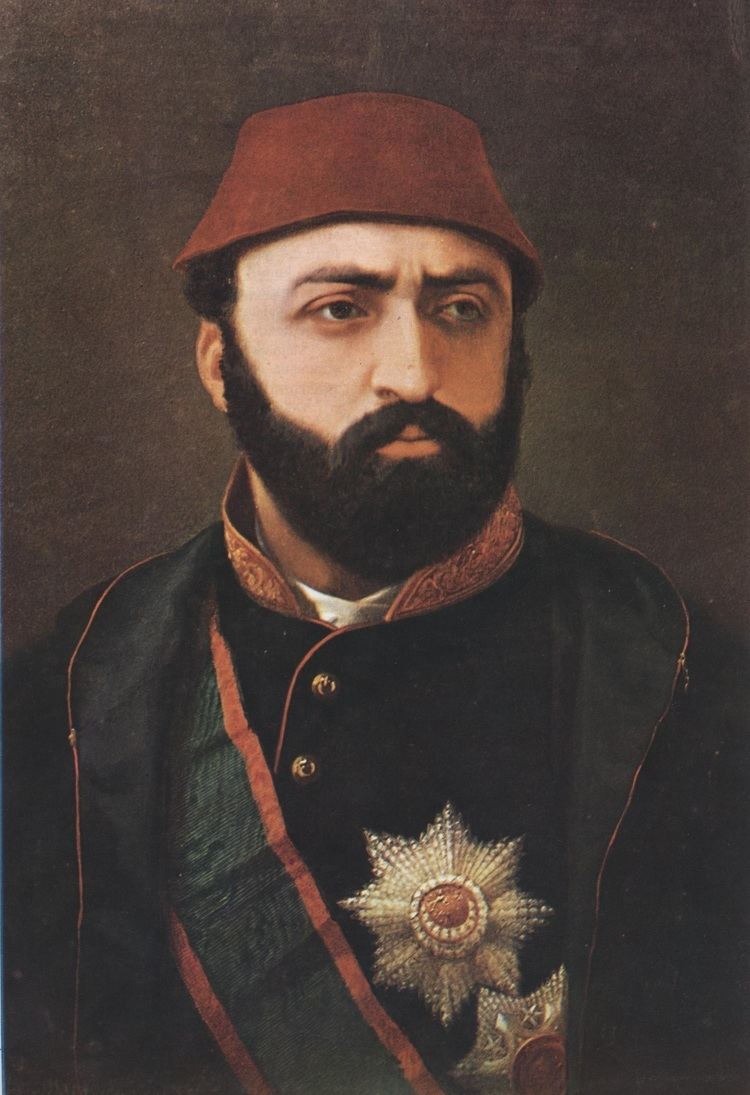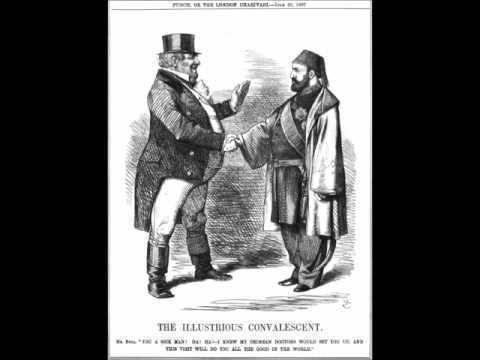Predecessor Abdülmecid I Dynasty Osmanli (Ottoman) Siblings Abdulmejid I | Successor Murad V Father Mahmud II | |
 | ||
Reign 2 June 1861 – 30 May 1876 Consorts Dürrünev Kadın
Edadil Kadın
Hayranidil Kadın
Neşerek Kadın
Gevheri Kadın Died 4 June 1876, Beşiktaş, Istanbul, Turkey Spouse Gevheri Kadın (m. 1872) Children Abdulmejid II, Şehzade Yusuf Izzeddin, Nazime Sultan Parents Pertevniyal Sultan, Mahmud II Similar Abdulmejid I, Abdul Hamid II, Mahmud II, Murad V, Abdul Hamid I | ||
Abdülaziz of the Ottoman Empire or Abdülaziz I (Ottoman Turkish: عبد العزيز / `Abdü’l-`Azīz, Turkish: I. Abdülaziz; 9 February 1830 – 4 June 1876) was the 32nd Sultan of the Ottoman Empire and reigned between 25 June 1861 and 30 May 1876. He was the son of Sultan Mahmud II and succeeded his brother Abdülmecid I in 1861.
Contents

Born at Eyüp Palace, Constantinople (present-day Istanbul), on 9/18 February 1830, Abdülaziz received an Ottoman education but was nevertheless an ardent admirer of the material progress that was made in the West. He was the first Ottoman Sultan who travelled to Western Europe, visiting a number of important European capitals including Paris, London and Vienna in the summer of 1867.

Apart from his passion for the Ottoman Navy, which had the world's third largest fleet in 1875 (after the British and French navies), the Sultan took an interest in documenting the Ottoman Empire. He was also interested in literature and was a talented classical music composer. Some of his compositions, together with those of the other members of the Ottoman dynasty, have been collected in the album "European Music at the Ottoman Court" by the London Academy of Ottoman Court Music.

Early life

His parents were Mahmud II and Pertevniyal Sultan. (1812–1883), originally named Besime, a Circassian. He was a quarter French. In 1868 Pertevniyal was residing at Dolmabahçe Palace. That year Abdülaziz led the visiting Eugénie de Montijo, Empress of France, to see his mother. Pertevniyal perceived the presence of a foreign woman within her quarters of the seraglio as an insult. She reportedly slapped Eugénie across the face, almost resulting in an international incident. According to another account, Pertevniyal became outraged by the forwardness of Eugénie taking the arm of one of her sons while he gave a tour of the palace garden, and she gave the Empress a slap on the stomach as a possibly more subtly intended than often represented reminder that they were not in France. The Pertevniyal Valide Sultan Mosque was built under the patronage of his mother. The construction work began in November 1869 and the mosque was finished in 1871.
His paternal grandparents were Sultan Abdul Hamid I and Sultana Nakşidil Sultan. Several accounts identify his paternal grandmother with Aimée du Buc de Rivéry, a cousin of Joséphine de Beauharnais. Pertevniyal was a sister of Khushiyar Qadin, third wife of Ibrahim Pasha of Egypt. Khushiyar and Ibrahim were the parents of Isma'il Pasha.
Reign
Between 1861 and 1871, the Tanzimat reforms which began during the reign of his brother Abdülmecid I were continued under the leadership of his chief ministers, Mehmed Fuad Pasha and Mehmed Emin Âli Pasha. New administrative districts (vilayets) were set up in 1864 and a Council of State was established in 1868. Public education was organized on the French model and Istanbul University was reorganised as a modern institution in 1861. He was also integral in establishing the first Ottoman civil code.
Abdülaziz cultivated good relations with the Second French Empire and the British Empire. In 1867 he was the first Ottoman sultan to visit Western Europe; his trip included a visit to the United Kingdom, where he was made a Knight of the Garter by Queen Victoria and shown a Royal Navy Fleet Review with Ismail Pasha. He travelled by a private rail car, which today can be found in the Rahmi M. Koç Museum in Istanbul. His fellow Knights of the Garter created in 1867 were Charles Gordon-Lennox, 6th Duke of Richmond, Charles Manners, 6th Duke of Rutland, Henry Somerset, 8th Duke of Beaufort, Prince Arthur, Duke of Connaught and Strathearn (a son of Queen Victoria), Franz Joseph I of Austria and Alexander II of Russia.
Also in 1867, Abdülaziz became the first Ottoman Sultan to formally recognize the title of Khedive (Viceroy) to be used by the Vali (Governor) of the Ottoman Eyalet of Egypt and Sudan (1517–1867), which thus became the autonomous Ottoman Khedivate of Egypt and Sudan (1867–1914). Muhammad Ali Pasha and his descendants had been the governors (Vali) of Ottoman Egypt and Sudan since 1805, but were willing to use the higher title of Khedive, which was unrecognized by the Ottoman government until 1867. In return, the first Khedive, Ismail Pasha, had agreed a year earlier (in 1866) to increase the annual tax revenues which Egypt and Sudan would provide for the Ottoman treasury. Between 1854 and 1894, the revenues from Egypt and Sudan were often declared as a surety by the Ottoman government for borrowing loans from British and French banks. After the Ottoman government declared a sovereign default on its foreign debt repayments on 30 October 1875, which triggered the Great Eastern Crisis (1875–78) in the empire's Balkan provinces that led to the devastating Russo-Turkish War (1877–78) and the establishment of the Ottoman Public Debt Administration in 1881, the importance for Britain of the sureties regarding the Ottoman revenues from Egypt and Sudan increased. Combined with the much more important Suez Canal which was opened in 1869, these sureties were influential in the British government's decision to occupy Egypt and Sudan in 1882, with the pretext of helping the Ottoman-Egyptian government to put down the Urabi Revolt (1879–1882). Egypt and Sudan (together with Cyprus) nominally remained Ottoman territories until 5 November 1914, when the British Empire declared war against the Ottoman Empire during World War I.
In 1869, Abdülaziz received visits from Eugénie de Montijo, Empress consort of Napoleon III of France and other foreign monarchs on their way to the opening of the Suez Canal. The Prince of Wales, the future Edward VII, twice visited Constantinople.
By 1871 both Mehmed Fuad Pasha and Mehmed Emin Âli Pasha were dead. The Second French Empire, his Western European model, had been defeated in the Franco-Prussian War by the North German Confederation under the leadership of the Kingdom of Prussia. Abdülaziz turned to the Russian Empire for friendship, as unrest in the Balkan provinces continued. In 1875, the Herzegovinian rebellion was the beginning of further unrest in the Balkan provinces. In 1876, the April Uprising saw insurrection spreading among the Bulgarians. Ill feeling mounted against Russia for its encouragement of the rebellions.
While no one event led to his being deposed, the crop failure of 1873 and his lavish expenditures on the Ottoman Navy and on new palaces which he had built, along with mounting public debt, helped to create an atmosphere conducive to his being overthrown. Abdülaziz was deposed by his ministers on 30 May 1876; his death at Feriye Palace in Constantinople a few days later was documented as a suicide at the time, although in Sultan Abdulhamid II's recently surfaced memoirs, the event is described as an assassination by the order of Hüseyin Avni Pasha and Midhat Pasha. When Sultan Murad V began to show signs of paranoia, madness and continuous fainting and vomiting even on the day of his coronation and threw himself into a pool yelling at his guards to protect his life, they were afraid the public would become outraged and revolt to bring the former Sultan back. Within a few days, on 4 June 1876, they arranged for Sultan Abdülaziz to kill himself with scissors, cutting his two wrists at the same time. It was unclear how the Sultan got hold of scissors in his tower prison cell and how he managed to cut two wrists at once, since no autopsy was allowed afterwards. The event was recorded as suicide officially and he was buried in Constantinople.
Achievements
Family
Abdülaziz married five times, and had twelve children.
